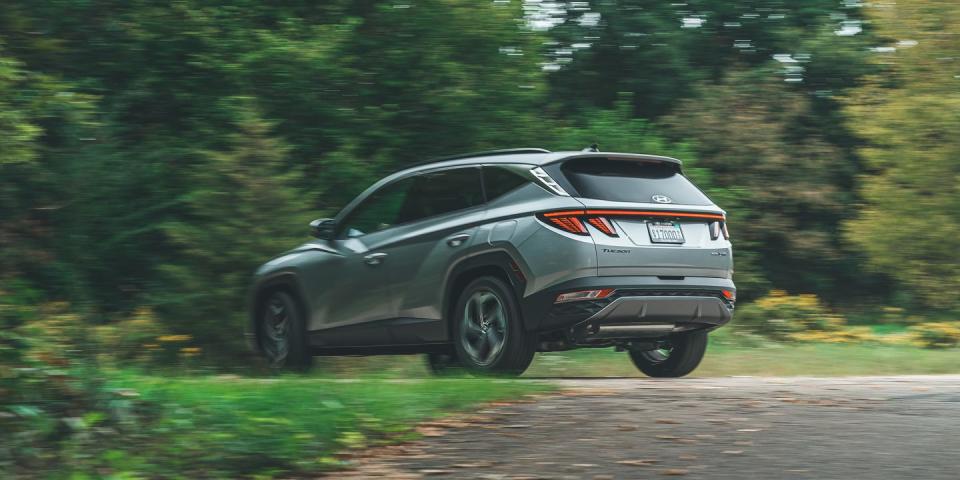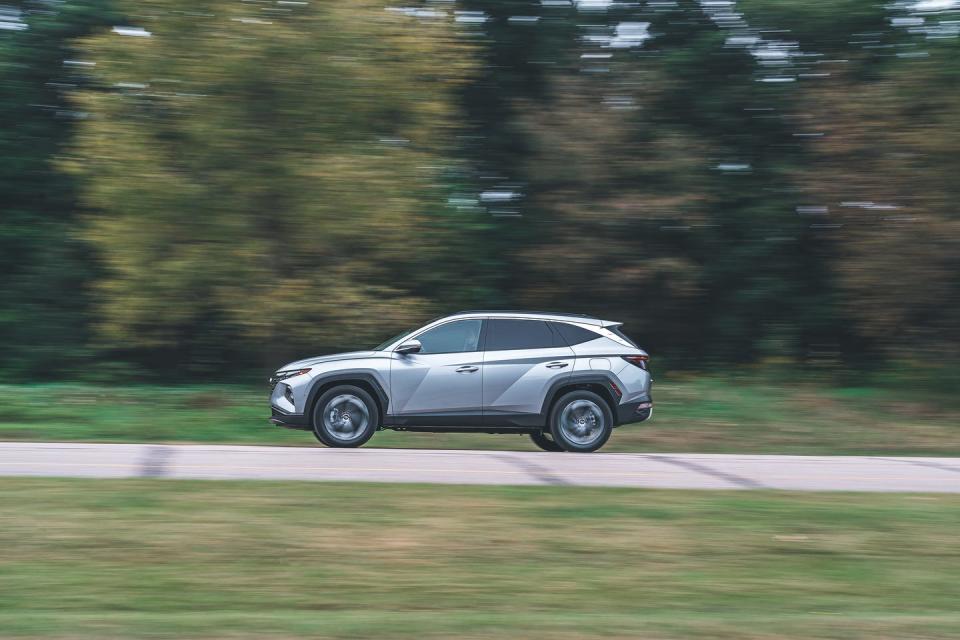Tested: 2022 Hyundai Tucson Hybrid Aids Mileage and Performance

Redesigned for 2022, the Hyundai Tucson rises from the mire of compact-crossover mediocrity with its exterior design, rich features set, and polished demeanor. Its standard engine, though, delivers tepid acceleration. Thankfully, electrification rides to the rescue on its battery-powered horse, giving the Tucson hybrid not only better gas mileage but also a welcome shot of adrenaline.
Fuel economy is any hybrid's calling card, so we'll start there. EPA estimates for the Tucson hybrid with standard all-wheel drive are 37 mpg city and 36 mpg highway, or 38/38 mpg for the base Blue model. That's a big jump up from the regular Tucson, with its 2.5-liter four-cylinder and all-wheel drive, which carries estimates of 24/29 mpg.

Next to other all-wheel-drive hybrid compact SUVs, the Tucson isn't quite as impressive. The Honda CR-V's estimates are 40/35 mpg, while those for the Toyota RAV4 (41/38 mpg) and the Ford Escape (43/37 mpg) are even better. And the Tucson hybrid underachieved in our 75-mph highway fuel-economy test, delivering just 28 mpg—that's disappointing, given that a Kia Sorento hybrid, which uses a front-wheel-drive version of the same powertrain, managed 42 mpg in the same test.
If the fuel-economy argument doesn't win you over, the hybrid's snappier acceleration might. Its 1.6-liter turbo four pairs with a 59-hp electric motor for a total of 226 horsepower and 258 pound-feet of torque, which betters the standard 2.5-liter by 39 horses and 80 pound-feet. Despite weighing 146 pounds more than the base-engine AWD Tucson, the hybrid can eclipse 60 mph in a comparably fleet 7.1 seconds versus a languid 8.8 for the standard Tucson. The Tucson hybrid also beat the 60-mph times of the hybrid RAV4, CR-V, and Escape. In the quarter-mile, it shows similar gains, with the hybrid completing a pass in 15.4 seconds at 91 mph versus 16.7 at 85 mph for the standard model. Again, the Tucson hybrid also tops its competitors. Passing performance is much improved as well. Accelerating from 50 to 70 mph took 4.6 seconds here—much quicker the base model's 6.0 seconds. Overall, drivers will find sufficient grunt to pull quickly away from a stop or get up to speed merging down a short on-ramp.

Unlike its rivals, the Tucson hybrid employs a six-speed automatic transmission rather than a CVT. That might sacrifice a measure of efficiency, but it makes for pleasant drivability without the slurred throttle response of a stepless transmission. The Tucson hybrid also avoids other common gas-engine drivability drawbacks. The handoffs between gasoline and electric propulsion are seamless, with the electric motor able to solely power the vehicle even at highway speeds, albeit under very light throttle applications. Despite the blending of regenerative and friction braking, there's no weirdness in the brake-pedal modulation. The hybrid also tows up to 2000 pounds, same as with the base engine. There is one drawback, though: The Tucson hybrid beeps when reversing, just like a Prius. That's annoying.
In contrast to its creased and faceted sheetmetal, the Tucson hybrid's driving experience smooths out the rough edges. The ride is well controlled, and the suspension can mask all but the sharpest bumps. We measured 70 decibels of noise under wide-open throttle, a quiet performance for a compact crossover. The hybrid's 0.84 g of grip on the skidpad just fractionally beats the regular Tucson's 0.83 g and also betters the Honda, Toyota, and Ford hybrids. We wouldn't go so far as to call this Hyundai's handling engaging—this is no Porsche Macan—although the steering is pleasantly weighted.

Outside of the mechanicals, the Tucson hybrid brings the same impressive packaging as the regular version. The new Tucson is 6.1 inches longer than before with a 3.4-inch longer wheelbase. That bigger box makes for 41.3 inches of rear-seat legroom, which surpasses even the spacious CR-V, and a six-footer has plenty of space sitting behind a similarly sized driver. The cargo volume of 39 cubic feet behind the rear seats and 75 with the rear seatbacks folded is among the most commodious in the segment (and no less than the nonhybrid Tucson).

 Yahoo Autos
Yahoo Autos 